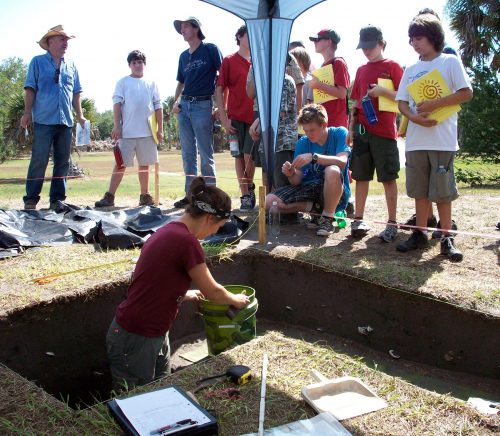On June 10th, the RRC participated in a Boy Scout training program organized by Matt Schuld of the Southwest Florida office of the Florida Public Archaeology Network and FGCU student/FPAN intern Dennis Kadera.

After a week of classes and activities at FGCU, eleven scouts and two scout- masters from Fort Myers Troop 1 met at the Calusa Heritage Trail for a Friday night orientation and camp-out. The scouts set up camp and explored the area in the evening, and especially enjoyed our newly completed observation pier on Waterfront Drive.
Saturday morning began with a tour of the Pineland Site Complex; we were lucky that UF grad student Melissa Ayvaz was still on site, working on her Citrus Ridge excavation, and the scouts were able to observe a real archaeological dig in process. Next we toured the labs and facilities at the Ruby Gill House and had a brief training on the archaeological materials from Pineland and the methods we use in collection and identification. Using ¼ – inch screens, the scouts helped us sift through material from what we call “Pile T” – a large unprovenienced sample from Brown’s Complex Mound 4 – finding and identifying pottery, fish bones, and shell tools.
We explained the importance of bagging and recording information from our finds, and discussed curation procedures at the Florida Museum of Natural History, the eventual permanent home of the material from Pile T.
After lunch, FPAN and RRC hosted Seminole Tribal Archaeologist Vanessa Poling, who gave a great talk on Seminole history and archaeology for the boys in our classroom at the Trail. Lastly, even though it was pretty hot, we had a class on physics and primitive echnology using the atlatl, or spear-thrower. All of the scouts did well throwing the six-foot darts, and we may have inspired an exciting physics project for school in the fall.
The scouts were exemplary guests, leaving nothing but footprints in their wake. We hope that they gained a deeper knowledge of their local history and archaeology as an academic profession while earning a merit badge (and having a good time) at the Calusa Heritage Trail.
This article was taken from the Friends of the Randell Research Center Newsletter Vol 10, No. 3. September 2011.